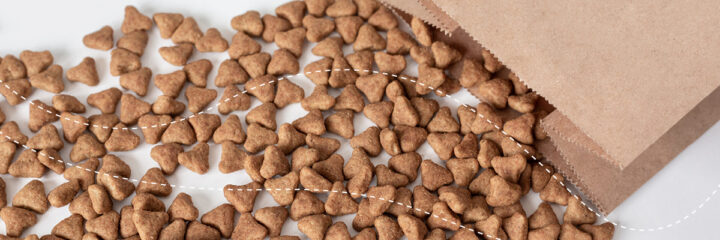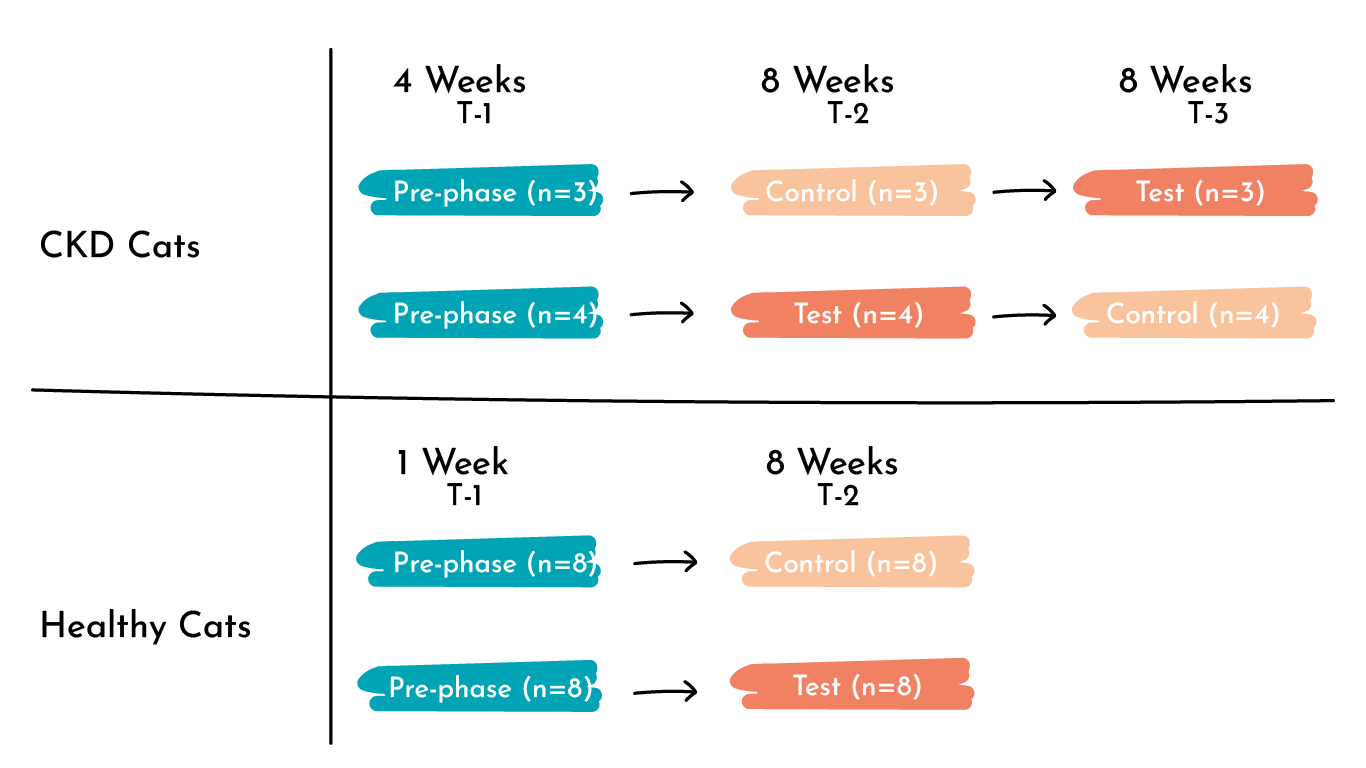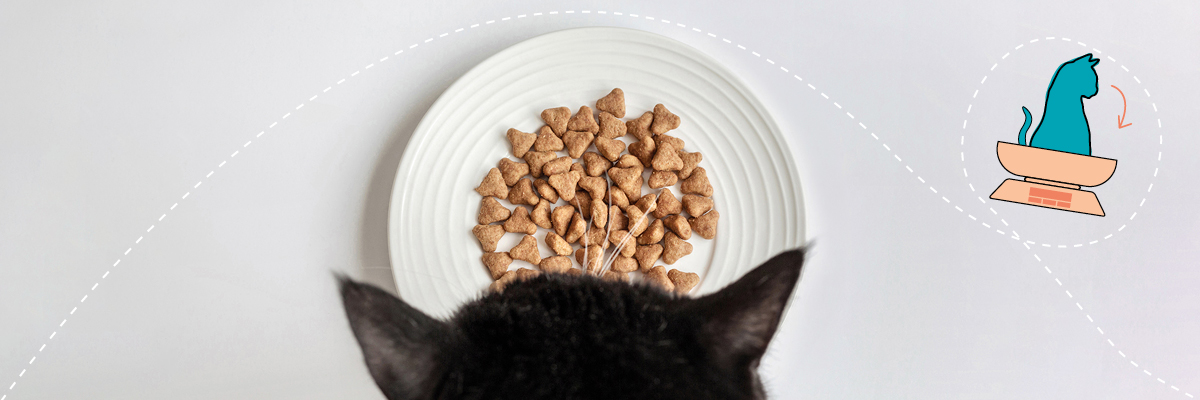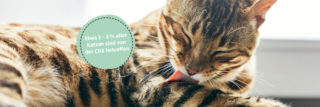
Cats with chronic kidney disease (CKD) progressively lose weight due to the disease and emaciate. Severe weight loss can contribute to a higher mortality rate in CKD cats (see blog post “Winning with weight“) and also worsen the cat’s condition overall. As cats are pure carnivores, they digest their own muscle if they do not consume enough protein in their food. This leads to muscle breakdown.
New study on kidney diet
An American study for and with the diet manufacturer Hills has used a new supplement (= additional feed or additive) in addition to their existing kidney diet. This food supplement consists of 0.5% betaine and prebiotics and was used in both healthy and cats with CKD (stages 1 and 2) in combination with Hills’ dry kidney diet. The seven CKD cats that received this combination for 8 weeks showed a positive difference in weight compared to the phase when they did not receive the supplement, but only the dry kidney diet. This difference was not shown in healthy cats. However, it also showed that both CKD and healthy cats initially lost weight when fed the diet food and only with the addition of the supplementary food did the CKD cats return to their initial weight respectively the healthy cats even exceeded it slightly.
Betaine
Betaine is an ammonium compound derived from the amino acid glycine. It is found in various vegetables (spinach, sugar beet, beetroot, wheat) and seafood (e.g. mussels and crabs). In human medicine, betaine is used in connection with therapies against cardiovascular diseases and a congenital disorder of the amino acid metabolism (= homocystinuria) and possibly also in fat metabolism disorders (only few data are available here), especially in connection with various B vitamins (folic acid, B6, B12).
The side effects that occur are described as follows:
- Loss of appetite,
- Restlessness,
- Sleep disturbance,
- Cerebral oedemaExcess fluid collecting in the tissues of the body, which can cause them to become swollen....,
- Psychological effects such as depression and personality disorders,
- Nausea,
- Vomiting,
- Diarrhoea,
- Stomach conditions,
- Dental conditions,
- Involuntary urination,
- Skin lesions,
- Hair loss
and several more. It is not known whether betaine causes cancer, so it should not be used in people who are pregnant or breastfeeding. There are a few (laboratory) studies from competitive athletic sports where high doses of betaine have a performance-enhancing effect and can contribute to increased muscle performance or muscle building. The group of betaines is used in the cosmetics industry as emulsifiers. The authors report that so far no weight gain has been achieved in humans with betaine.
Prebiotics: Food for intestinal bacteria
Prebiotics are plant substances that are indigestible for humans (dietary fibre). However, they are broken down by the preferred intestinal bacteria in the large intestine and serve as nourishment for them. In this way, prebiotics support the natural intestinal flora (intestinal microbiota). Short-chain fatty acids are formed through the breakdown of the plant substances, which in turn have a positive effect on intestinal health (promotion of the acidic intestinal environment, nourishment of the intestinal cells, promotion of natural intestinal movement). Prebiotics include inulin and the carbohydrates fructo-oligosaccharides (FOS) and galacto-oligosaccharides (GOS).
Inulin and FOS are found in various plants and vegetables such as Jerusalem artichokes, artichokes, chicory, leeks, garlic, onions, wheat, rye, salsify and green (= unripe) bananas.
GOS is passed on to the animal in high concentrations, especially through the mother’s milk. The above-mentioned feed supplement contains short-chain (= sc) fructo-oligosaccharides (= scFOS) in 0.487% and long-chain beta-glucans (0.586%) from wheat.
Beta-glucans are found in various cereals such as oats, barley, rye and wheat, bacteria, fungi, algae and yeasts. They are natural components of the cell wall. Wheat has by far the lowest beta-glucan content.
Beta-glucans are also food for the colon microbes. The desired intestinal bacteria convert beta-glucans into short-chain fatty acids. In humans, the health effect of beta-glucans is mainly based on the interaction of other ingredients of the above-mentioned cereals and cannot be achieved by food supplements with isolated beta-glucans.
Crossover experimental setup
The above mentioned study was carried out in such a way that all cats (test and control cats) first received the dry kidney diet for a period of 4 weeks in a preliminary phase. Then 7 cats with CKD (= experimental cats) were divided into two groups of 3 and 4 animals, respectively. The first group (3 CKD cats) continued to receive only the kidney diet for 8 weeks, the second group (4 CKD cats) received kidney diet plus the food supplement also for 8 weeks. Afterwards, the first group received the kidney diet and the food supplement for 8 weeks and the second group received only the kidney diet for 8 weeks. So the groups were switched after 8 weeks.
The 16 healthy cats (= control group) received dry kidney food (= kidney diet) for 1 week and then 8 cats received only the kidney diet for another 8 weeks and 8 cats received the kidney diet with the food supplement for 8 weeks.

Worsening under kidney diet?
It is interesting that the CKD cats had a higher average weight before the first feeding phase than during the feeding of the kidney diet. Although they ate more from the kidney diet than they did before. The same was true for the healthy cats.
In addition, the cats showed on average “better” kidney values in blood and urine (in blood: ureaUrea is the nitrogen-containing breakdown product of protein metabolism. The nitrogen from the proteins is converted to ammonia in the liver, which is combined with carbon dioxide to form urea. This is continuously excreted via the kidneys but also via sweat. Urea is one of..., creatinineCreatinine is a breakdown product of muscle metabolism. Its blood level is dependent, among many factors, on age, weight, nutritional status and muscle mass. Hence, creatinine levels in the blood vary from individual to individual. Creatinine is continuously excreted in the urine. Increased blood creatinine..., SDMASDMA = Symmetrical Dimethylarginine, which is a degradation product of the amino acid arginine and is excreted solely through the kidneys. SDMA is a highly specific biomarker for kidney function in cats. Read more: SDMA test (blood test)...; in urine: specific urine weight, UPC) before feeding than when fed the kidney diet alone.
When the kidney diet and the feed supplement were used, most of the kidney values (except for SDMA) returned to their original values. So did the weight.

Gradual deterioration
It is important to note that CKD in cats can lead to a gradual deterioration of the kidney values and also to a gradual weight loss. This progressive course is particularly to be expected in the late stages already over weeks and months.
In stage 1 and 2, a significantly longer constancy of the values over months and years is to be expected. All CKD cats in the trial were in stage 1 and 2. Nevertheless, it cannot be excluded that the kidney values and also the weight of the CKD cats deteriorated during the trial period due to the progression of CKD. However, the effect of weight reduction was also visible in the healthy cats that received the kidney diet. However, it was not statistically significant as it was in the CKD cats.
At the same time, the CKD cats that received the food supplement and kidney diet were shown to have higher blood levels of tryptophan breakdown products. Unfortunately, there is no comparison to the values before the feeding trial.
The intestinal bacteria (= microbes) form the so-called indole from the amino acid tryptophan. Indole is then absorbed from the intestine into the blood. Via the blood, indole reaches the liver, where the uraemic toxin indoxyl sulphate is formed from indole, which must be excreted via the kidneys. Elevated concentrations of indoxyl sulphate in the blood of CKD cats lead to reduced kidney performance.
Feeding kidney diet plus supplement to CKD cats showed reduced urinary excretion of indole metabolites. In the healthy cats, feeding the supplement resulted in a reduction of para-cresyl sulphate. Para-cresyl sulphate, like indoxyl sulphate, is one of the uraemic toxinsToxic, nitrogen-containing urinary substances responsible for uraemia and kidney damage.... formed by intestinal bacteria, which are not adequately excreted in chronic kidney disease and then accumulate in the blood. Both uraemic toxins have direct damaging effects on the kidneys and can thus increase the mortality rate. In addition, they are responsible for many symptoms associated with CKD, as they are also accumulated in other organs and lead to detrimental effects.
Indoxyl sulphate is also responsible for an imbalance (dysbiosisImbalance of organisms of the the microbiome (all microbes on or within an animal’s tissues), for instance the imbalance of the intestinal flora as part of the microbiome....) of the intestinal bacteria, whereby harmful intestinal bacteria predominate. This leads to an “overgrowth” of microbes that convert tryptophan to indole. In the process, the healthy intestinal bacteria are further suppressed.
Results
Simultaneous feeding of dry food diets with the above-mentioned feed supplement of betaine and prebiotics has a positive effect on the weight of the CKD cat compared to feeding the dry food kidney diet only. However, comparison to the baseline before feeding shows that the kidney diets lead to reduced weight. This was despite the fact that both the CKD cats and the healthy cats ate a larger amount of both the kidney diet and the combination than the cats ate before the feeding trial.
The authors report that the composition of the breakdown products from protein metabolism in the faeces of the CKD cats was changed when the combination was fed, compared to the renal feed alone. The authors interpret this change as a sign of a positive alteration in microbial activity. However, the proportion of tryptophan breakdown products in the faeces was increased in the CKD cats fed the combination. Cats that received the kidney diet and the feed supplement showed a reduced excretion of indoxyl sulphate in the urine. The authors consider this to be a positive sign of improved microbial activity, gut health and kidney function, respectively.
Unfortunately, there is no comparison between the corresponding values when feeding only the kidney diet and the comparative value before feeding the kidney dry feed. It would be theoretically possible that feeding the dry kidney diet already led to worse values compared to the values before the feeding trial. However, this remains unclear.
On the other hand, kidney diets are designed to contain less protein to reduce uraemic toxins, as protein is the source of uraemic toxins. Tryptophan, on the other hand, is an essential amino acid that must be provided in the diet. Therefore, a comparison against the baseline before feeding the kidney diet and not only between the kidney diet and feeding the combination would at least be interesting.
It is also possible in theory that due to the reduced excretion capacity in CKD, less indoxyl sulphate is excreted via the kidneys, but more indoxyl sulphate remains in the blood and is then accumulated in the organs and kidneys. These values are not given in the publication. Ultimately, the values are average values of 7 CKD cats in early IRIS stages 1 and 2. Whether the reduced excretion applies to all cats is not shown in the publication. There may be high individual variations. Furthermore, there is no comparison to the healthy cats and also in the healthy cats there is no information in the publication on the excretion behaviour of indoxyl sulphate before or after feeding the kidney diet or the combination.
To date, there are no publications on the use of the above combination in CKD cats in late IRIS stages 3 & 4. In addition, it is questionable or controversial to offer dry food as a complete diet to cats with kidney disease, as CKD cats should be provided with as much moisture as possible. The study also shows that the dry kidney food only is not sufficient to achieve a significant reduction in uraemic toxins even in early CKD stages. It is also not known whether the feed supplement alone achieves the effects obtained in the study and can also be administered in normal cat food, for example.
To reduce uraemic toxins, renal diets are protein-reduced as described above. However, protein reduction is limited in an obligate carnivore like the cat. If the cat does not consume enough protein in the diet, it digests its own muscle, which is also evident from a rise in creatinine in the blood. Protein reduction can create additional problems as it promotes hyperphosphatemia (see blog post “Phosphate in focus“), which can lead to another vicious cycle of kidney destruction.
Nevertheless, the results show that there may be new ways in the treatment of CKD in addition to renal diets and that uraemic toxins can and should be reduced in alternative ways besides renal diets to slow down the progression of CKD. Another approach to reducing uraemic toxins – regardless of the type of feeding – is a special high performance adsorber designed to reduce uraemic toxins only. More on this can be read in my blog post “Lessons learned from human medicine”.
Bibliography:
- Hall, J. A.; Jewell, D. E. & Ephraim, E. (2022): Feeding cats with chronic kidney food supplemented with betaine and prebiotics increases total body mass and reduces uremic toxins, PLoS ONE 17(5): e0268624. https://doi.org/10.1371/journal.pone.0268624 , S. 1–19.
Betain bzw. Betaine
- https://flexikon.doccheck.com/de/Betain
- https://de.wikipedia.org/wiki/Betain
- Senesi, P., Luzi, L.; Montesano, A.; Mazzocchi, N. & Terruzzi, I. (2013): Betaine supplement enhances skeletal muscle differentiation in murine myoblasts via IGF-1 signaling activation, Journal of Translational Medicine, 11, S. 174.
Prebiotics
Beta-Glucane:
- Fachgesellschaft für Ernährungstherapie und Prävention (FETev): https://fet-ev.eu/beta-glucane/


